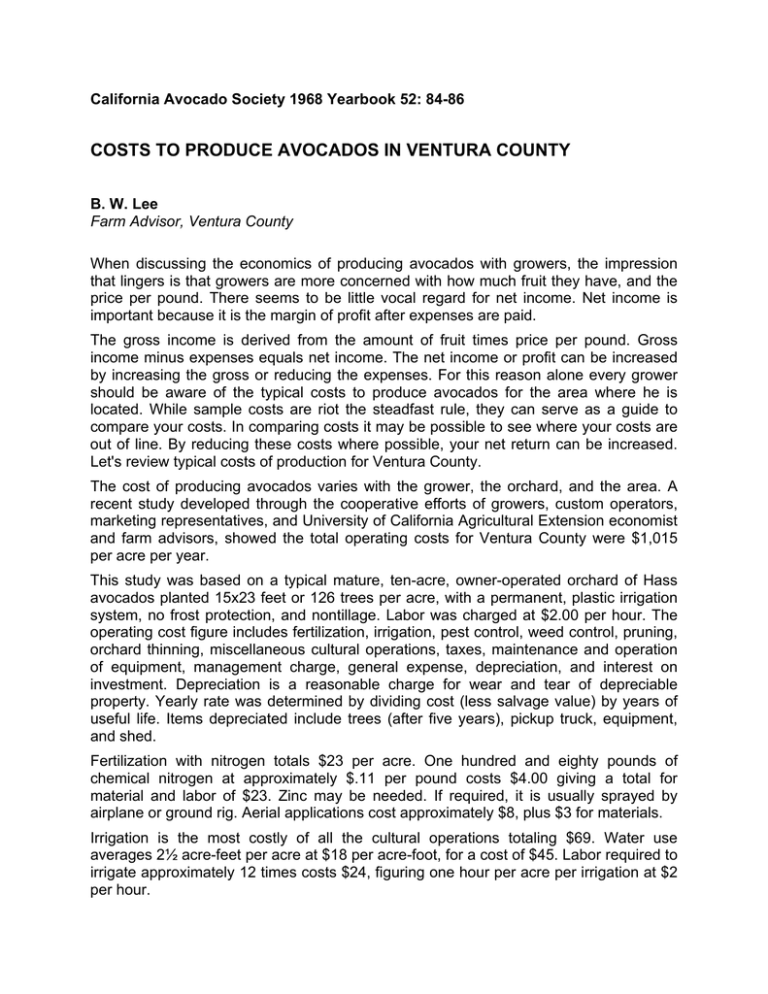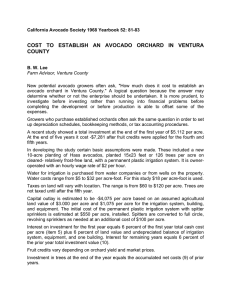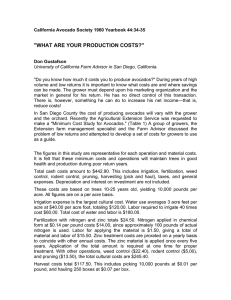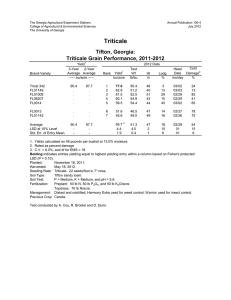COSTS TO PRODUCE AVOCADOS IN VENTURA COUNTY
advertisement

California Avocado Society 1968 Yearbook 52: 84-86 COSTS TO PRODUCE AVOCADOS IN VENTURA COUNTY B. W. Lee Farm Advisor, Ventura County When discussing the economics of producing avocados with growers, the impression that lingers is that growers are more concerned with how much fruit they have, and the price per pound. There seems to be little vocal regard for net income. Net income is important because it is the margin of profit after expenses are paid. The gross income is derived from the amount of fruit times price per pound. Gross income minus expenses equals net income. The net income or profit can be increased by increasing the gross or reducing the expenses. For this reason alone every grower should be aware of the typical costs to produce avocados for the area where he is located. While sample costs are riot the steadfast rule, they can serve as a guide to compare your costs. In comparing costs it may be possible to see where your costs are out of line. By reducing these costs where possible, your net return can be increased. Let's review typical costs of production for Ventura County. The cost of producing avocados varies with the grower, the orchard, and the area. A recent study developed through the cooperative efforts of growers, custom operators, marketing representatives, and University of California Agricultural Extension economist and farm advisors, showed the total operating costs for Ventura County were $1,015 per acre per year. This study was based on a typical mature, ten-acre, owner-operated orchard of Hass avocados planted 15x23 feet or 126 trees per acre, with a permanent, plastic irrigation system, no frost protection, and nontillage. Labor was charged at $2.00 per hour. The operating cost figure includes fertilization, irrigation, pest control, weed control, pruning, orchard thinning, miscellaneous cultural operations, taxes, maintenance and operation of equipment, management charge, general expense, depreciation, and interest on investment. Depreciation is a reasonable charge for wear and tear of depreciable property. Yearly rate was determined by dividing cost (less salvage value) by years of useful life. Items depreciated include trees (after five years), pickup truck, equipment, and shed. Fertilization with nitrogen totals $23 per acre. One hundred and eighty pounds of chemical nitrogen at approximately $.11 per pound costs $4.00 giving a total for material and labor of $23. Zinc may be needed. If required, it is usually sprayed by airplane or ground rig. Aerial applications cost approximately $8, plus $3 for materials. Irrigation is the most costly of all the cultural operations totaling $69. Water use averages 2½ acre-feet per acre at $18 per acre-foot, for a cost of $45. Labor required to irrigate approximately 12 times costs $24, figuring one hour per acre per irrigation at $2 per hour. Other cultural costs include: pest control at $12 per acre — is the cost for controlling rodents, snails and ants; weed control at $21, using one application of herbicide and spot-spraying with oil twice during the summer; pruning costs $35 per acre, consisting of removing dead wood, pruning up the skirts to permit better distribution of water, and orchard thinning at 8 to 12 years to prevent crowding; miscellaneous operations such as propping, erosion control, supplies and tools, $36 per acre. In summary, the total cultural costs are as follows: materials and equipment $95, and $112 for labor, giving a total of $207 per acre. Overhead operating costs include: taxes at $90 per acre, maintenance and repairs $20. management charge at $3 per acre per month totals $36, and general expenses (insurance, office supplies, telephone, dues, laboratory services) of $20. The total cash overhead costs are $166 per acre. The management charge has been added to the study because many growers are now using custom grove managers to oversee the operation and make management decisions. The operating costs, including both cultural and cash overhead, come to a total cash pre-harvest cost of $373. The non-cash cost, including depreciation at $315 per acre and interest on investment of $327, adds $642 to the pre-harvest cost of $373, giving a grand total of pre-harvest cost of $1,015 per acre. For growers who do not wish to charge interest on investment as a cost against the orchard, they may subtract the $327 from the $1,015 which will give a pre-harvest cost of $688 per acre. Interest on investment is charged at the rate of 6% on an assumed land value of $3,000 per acre plus half life value on trees, equipment, and buildings. Harvest costs vary from 1½ to 3 cents per pound, depending on tree size, size of crops, terrain, etc. A 5% assessment is made on the value of the crop at roadside after harvesting. This money is used for industry advertising and promotion. Yield per acre varies by varieties, location, cultural practices, type of tree, and climatic conditions. Average good commercial yields per acre in Ventura County range from 8,000 to 10,000 pound for Hass. Yields of 28,000 pounds have been recorded on 12year-old trees but it is the exception rather than the rule. The accompanying table shows the breakdown of costs which should be given consideration in figuring the cost of producing an acre of avocados in Ventura County. The author wishes to acknowledge all those individuals who assisted with this study and especially to Dr. Robert C. Rock, Extension Economist, University of California Riverside.



